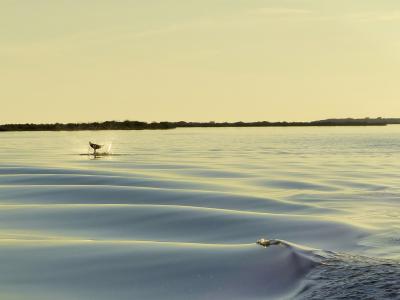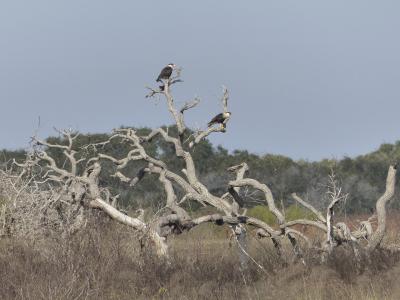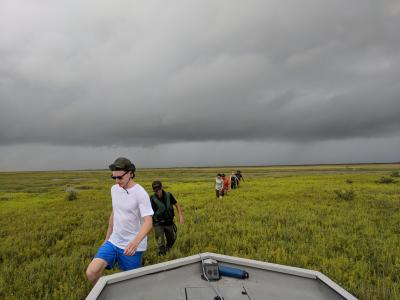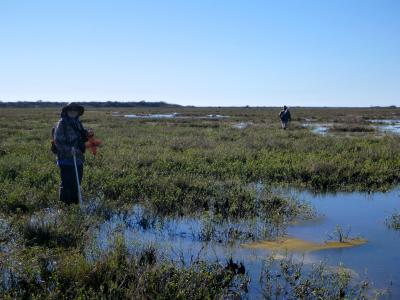The Call of the Crane
Whooping Cranes face many threats on their road to recovery. In Texas, Earthwatch
volunteers are working to help researchers ensure that the last wild migratory population
of these birds and their habitat are around for years to come.
By Dianna Bell
.
Landing in the Lone Star State
The Gulf Coast of Texas is flat. So flat you can see the oil rigs miles away. The hour-and-a-half drive from Corpus Christi International Airport to Austwell—a city comprised of 0.4 square miles and 149 people—brought rows and rows of recently plowed earth, bisected by the occasional dirt road and ramshackle barn.
But upon pulling up to my home for the week—a little white cabin at Hopper’s Landing, well-worn from years of hosting seasonal fishermen—I was greeted by the San Antonio Bay. And just three miles down the road is the gate to Aransas National Wildlife Refuge, 114,657 acres of protected marshland, and winter home to the endangered Whooping Cranes.
.
Farmland in coastal Texas.
.
These birds are a sight to behold, with snow white feathers and a shock of red skin crowning their heads. As the tallest bird in North America at a whopping five feet, with a wingspan one-and-a-half times wider, Whooping Cranes are the rarest of the 15 crane species, and a testament to the power of conservation and the individuals determined to save them.
You might think, as I mistakenly did, that folks living here in the Gulf of Mexico wouldn’t be as concerned with saving a bird when there are bigger fish to fry—oil drilling and water supplies to name just a couple. But the Whooping Crane doesn’t stand alone as a separate entity in the environmental realm; it is just one part of the entire picture.
The people in the area have really embraced this crane, hosting the celebratory Annual Whooping Crane Festival, and they’re proud that the birds venture down every year, choosing to return to a place that they too call home.
In March, I got a weeklong introduction to both the bird and its habitat, and in the process, I began to understand why they care so much. I was presented with the opportunity to volunteer on the Earthwatch expedition Protecting Whooping Cranes and Coastal Habitats in Texas, and to be honest, I accepted the offer with trepidation. Of the plethora of charismatic species, exotic locales, and research projects Earthwatch funds around the world, Whooping Cranes and Texas were low on my list. I had never been too interested in birds, and the Lone Star State wasn’t exactly my number one destination.
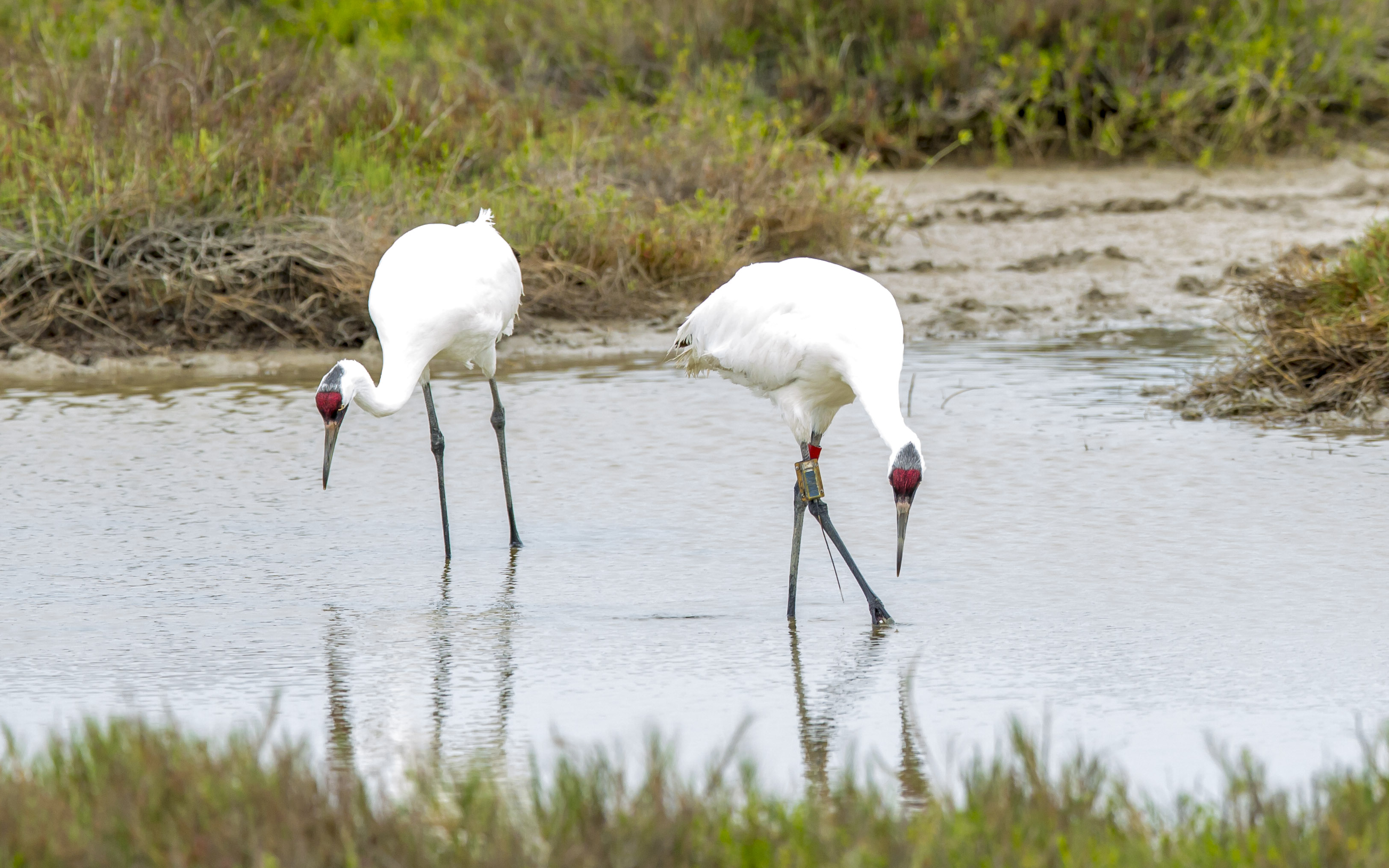
But I grew to not just accept these strange birds, with their loud honking calls and standoffish demeanor, I embraced them, becoming passionate about their story and enthralled with the coastal landscape.
Each day began out on the water, cruising along the shoreline in the research boat, binoculars to our eyes as my teammates and I diligently looked for any sight of white plumage. As the sun inched its way upward and the wind whipped through our hair, dolphins would make their presence known, rolling through the wake of our boat with ease. This became my favorite morning ritual, coupled with the joy of spotting a pair of cranes beginning their foraging for the day, their heads popping up above the scruffy vegetation as they took notice of us.
Aransas National Wildlife Refuge is more than any one plant or animal. It’s an entire ecosystem filled with interconnected and complex relationships, of which the Whooping Crane happens to play a part. It’s a place that many people are working to protect, including Felipe Prieto, wildlife refuge specialist with the U.S. Fish and Wildlife Service.
“It is important to preserve these lands and to have a voice for these resources,” Felipe said. “You know they don’t talk. The trees don’t talk, the animals don’t talk, so we have to talk for them.”
.
.
A Bird in the Hand
Whooping Cranes are finicky creatures, requiring large swaths of land for their habitat—between 125 to 500 acres of land per pair, which they fiercely defend, year after year. While these birds are protected within the borders of Aransas National Wildlife Refuge and surrounding areas, they can run into trouble when they wander outside of these confines.
But these whoopers, as they’re fondly called, have intrepid advocates on their side: from government organizations in both Canada and the U.S., the federal protections that accompany their endangered status, to conservation organizations like the International Crane Foundation (ICF) and National Audubon Society, and passionate individuals. The shield of their power, while not impenetrable, has kept the cranes from crossing the brink to extinction.
Dr. Elizabeth “Liz” Smith is one part of that shield. As senior Whooping Crane scientist and director of the Texas program for the International Crane Foundation, she knows just how diligent you have to be to keep the future of this species on a positive trajectory.
“The crane conservation community, that includes agencies and NGOs, work together to try to educate hunters so they don’t accidentally shoot a Whooping Crane,” Liz said. “For those that are just vandal shooters, that are just shooting because they don’t respect life, we are trying to make sure that they are getting a stiff sentence and that they are getting prosecuted to show that we don’t tolerate that.”
Last year, when two Whooping Cranes from a reintroduced population in Louisiana were found shot and killed in eastern Texas, the environmental community sprang into action. Local farmers provided statements to help the Texas game wardens and U.S. Fish and Wildlife Service special agents track down the 18-year-old perpetrator, Trey Frederick, and hunters came forward to fill in the details of the maliciousness of the crime.
Liz spoke with Frederick during his arraignment, hoping to gain some insight into his actions and help guide him in better understanding his errors.
“He really did try to seem remorseful, but there were so many things that he did leading up to that crime, that he lied to me about,” Liz said during our interview in May. “He was very convincing. I told him to plead guilty and we would see what we could do about helping him straighten up his life. He admitted that he did it, but said that he wasn’t going to plead guilty because he might be able to get out of it. That was kind of it for me.”
Under the Endangered Species Act, the maximum criminal penalties for knowingly bringing danger or death to an endangered animal are fines of up to $100,000 and a year of jail time. In practice, however, perpetrators have received anywhere from $1 to $85,000 in fines, rarely serving any time.
Knowing this, Liz wrote a letter to the judge and district attorney of the case urging them to apply the harshest sentence, explaining the time, effort, and money that is poured into rearing each and every crane.
.
The shooter did not just kill two birds. The shooter stole the deep monetary investment of governments and nonprofit organizations in Canada and the United States. The shooter endangered the very existence of this struggling species.
— Dr. Liz Smith
.
When the ruling was delivered, Liz was pleased. Frederick was ordered to pay almost $26,000 in restitution, serve 200 hours of community service, and was sentenced to five years of probation, during which his hunting and fishing licenses were revoked in all fifty states and he couldn’t own a firearm.
“He’s young. We are hoping that he can change,” Liz said. “Time will tell if he will turn his life around. We will see.”
So far, this young man hasn’t made much progress. In July of this year, he was sentenced to 11 months in federal prison after a confidential informant told officials that Frederick had participated in hunting feral hogs from a public road and committed acts of animal cruelty. (For the gruesome details, read Sonia Smith’s piece for Texas Monthly.)
The severity and seriousness with which this was handled points to positive signs for Whooping Crane populations, and while there is still a ways to go, Liz is hopeful.
“Eventually, we would like to see them all across the southern United States and flying and nesting in different places, just like they used to,” she said.
.
.
Hope is the Thing with Feathers
At one time, Whooping Crane populations were estimated to have totaled around 10,000. But by 1941, only 15 cranes remained in the migratory population, their numbers decimated due to over-hunting and habitat loss. And since then, it’s been a long and slow road to recovery for this species. In order to downlist the cranes from endangered to vulnerable, their numbers will need to reach a population size of 1,000. Currently, there are around 650. Not an impossible goal to achieve, but it will take time, and substantial conservation effort.
CBS’s “Sunday Morning” gives a glimpse into Aransas National Wildlife Refuge.
.
At the very tippy-top of Alberta, in Canada’s Wood Buffalo National Park, Whooping Cranes make their nests, pulling vegetation together in the middle of shallow water areas, which makes it easier to see and hear any potential approaching predators. They typically lay between one to three eggs in a season, and after a month of incubation, the chicks hatch and must learn survival skills fairly quickly. Usually, only one chick survives—infanticide is common. In just a few months, it will be time to begin the journey south.
Beginning in December, fluffy white dots mark the marshy landscape of Texas’s Gulf Coast. The cranes have arrived to find a mate, and to eat all of the blue crabs and wolfberries they can find for the next four to five months. And this is where I find them, spying through my binoculars as I monitor their behavior.
I’m accompanied by nine other citizen scientists as part of an Earthwatch crew working with aquatic ecosystem ecologist Dr. Jeffrey Wozniak and avian ecologist Lindsey Tiegs. As one person holds the timer, another records the activity, and the others have their eyes on the birds, calling out the behaviors they see.
“Three...two...one...mark!”
“Foraging!” “Alert!” “Comfort!” “Resting!” “Locomotion!”
.
Hope is the thing with feathers
That perches in the soul
And sings the tune without the words,
And never stops at all,
And sweetest in the gale is heard;
And sore must be the storm
That could abash the little bird
That kept so many warm.
I’ve heard it in the chillest land,
And on the strangest sea;
Yet, never, in extremity,
It asked a crumb of me.
— Emily Dickinson
.
Why is it important to record the behaviors of these birds? By monitoring the cranes, we can get a sense of their habitat. If the birds spend much of their time walking around the marsh in search of food, you can surmise the habitat might not be overflowing with resources. If the birds spend their time foraging, resting or “comforting” (preening and cleaning themselves), food must abound. If the birds are alert—necks straight and taught with their beaks parallel to the ground—they might sense some kind of danger or perceived threat, perhaps caused by a passing airplane or boat, or another crane encroaching on their territory.
We view the birds from 300 yards away, and when they aren’t in their territory, we sneak in to assess the area. We trudge through the muck and mud of the marsh, marking out transects, counting wolf berries and blue crabs, and measuring water salinity.
Aside from providing crucial habitat data, we’re also helping to create a more complete picture, Jeff said. “We don’t always have every piece of the puzzle, so that’s the drive for us to keep coming back. It’s important to understand how this system works, how we as humans impact it, and how we can mitigate those impacts.”
And with the 10 pairs of extra hands Earthwatch volunteers provide for the week I’m there, we’re helping Jeff and Lindsey collect the data they need, but at a much quicker pace.
“Earthwatch is enabling us to hit more sites, to have more time on the marsh, to collect more data, to observe more birds. It’s maximizing our efforts,” Jeff said. “We can’t put that puzzle together if we don’t have the data, and Earthwatch is enabling us to do that.”
While we were only there for a week, adding our findings to a much larger collection of data, I couldn’t help but feel like I was being woven into the conservation story of the Whooping Crane—a story that I hope has many chapters ahead...and, even more importantly, a happy ending.
.
To experience these majestic birds for yourself, join Earthwatch teams fielding in December through March on the expedition Protecting Whooping Cranes and Coastal Habitats in Texas.
If you have any comments or questions related to this story, please contact us at communications@earthwatch.org. We welcome your feedback.
Sign up for the Earthwatch Newsletter
Be the first to know about new expeditions, stories from the field, and exciting Earthwatch news.
